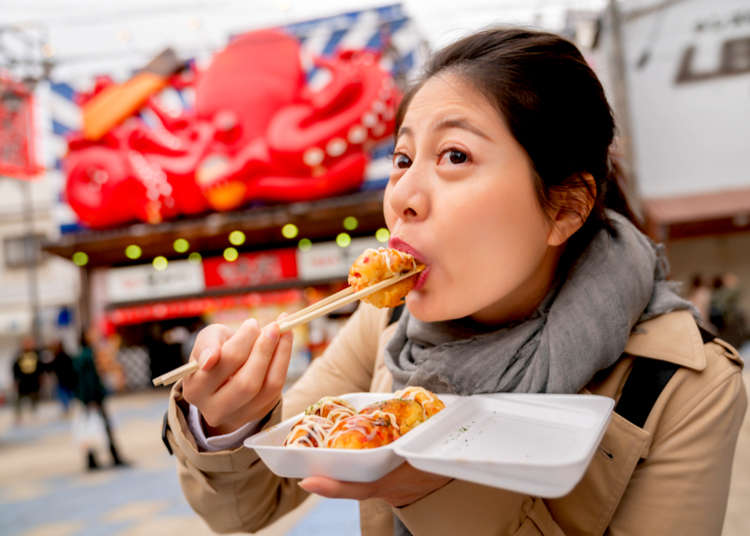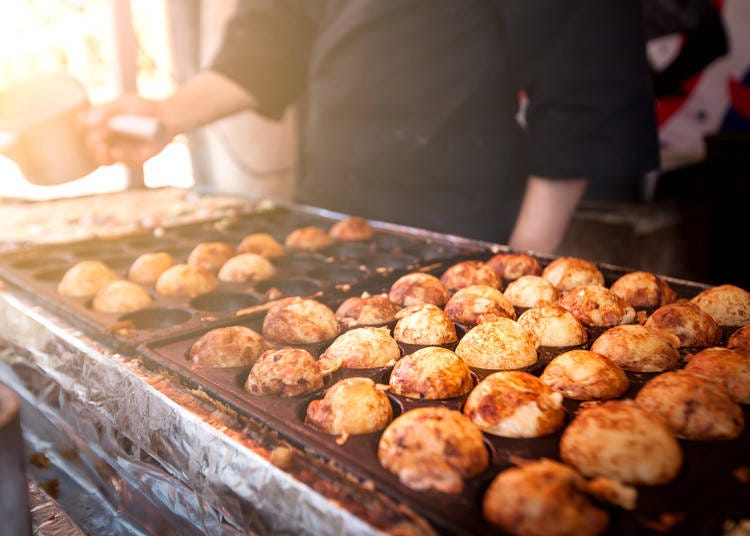
Whether at a bustling festival or a cozy street stall, takoyaki is a symbol of Japanese street food. These savory octopus-filled dough balls are an irresistible treat for locals and tourists alike.
- Table of Contents
-
- 1. Octopus Balls!? Quick Look at the History of Takoyaki!
- 2. When do Japanese Eat Takoyaki? The Staple Food of Festivals!
- 3. Takoyaki Recipe: Ingredients & Preparation
- 4. Making Takoyaki at Home - Customize the Traditional Takoyaki Recipe with Sausage, Cheese, and More!
- 5. Enjoying Takoyaki in Japan
1. Octopus Balls!? Quick Look at the History of Takoyaki!

Now while takoyaki are typically filled with octopus meat, takoyaki's predecessor was filled with beef!
So exactly what is takoyaki? The English translation - Japanese octopus balls - might not create the right image! Takoyaki is a round, fried food made from batter, small pieces of tender octopus and other ingredients, like green onions and ginger. They are considered a Japanese street food are popular at festivals, often prepared from food stands right in front of the prospective customers.
However, takoyaki can also be found being sold at convenience stores, food trucks, and in people's homes as well! Though, be warned, takoyaki is usually served piping hot! So be sure to give it time to cool while you sip on a beer.
Brief history of Takoyaki
Takoyaki is said to originally be from Osaka, where, according to one theory, a street vendor called Tomekichi Endo invented this delicious octopus dish in 1935. However, it wasn’t an invention out of the blue but rather an adaption of a previous version.
Supposedly, it all started with another dish called choboyaki, the prototype of takoyaki as we know it today. Choboyaki is rather similar in ingredients, but in appearance it is more like a flat rectangle rather than individual balls.
From choboyaki evolved rajioyaki, likely named after the newest, most popular invention of the time: the radio. The characteristic ball shape was introduced with rajioyaki, and the dish was generally filled with beef. When the beef filling was replaced with octopus cuts, Japanese octopus balls - takoyaki - was born.
Ever since then, the dish has conquered the taste buds of Japan by storm. It is a staple food of Japanese festivals, sold in stalls called yatai, and can also be found in shops and restaurants all around the country. Likewise, different regional varieties of takoyaki have developed over time as the dish has migrated.
2. When do Japanese Eat Takoyaki? The Staple Food of Festivals!

Now that we know what is takoyaki, when do Japanese eat it? Takoyaki goes with Japanese summer festivals like ketchup goes with French fries. At stalls and restaurants, takoyaki is often served in paper dishes resembling little boats. Don’t be surprised when you’re served a toothpick instead of chopsticks to eat your takoyaki with.
Spear the ball and try to eat it while taking care not to burn your mouth! There’s nothing more satisfying than to snack on freshly made takoyaki while celebrating two heavenly lovers at the Tanabata festival, after dancing the bon-odori during Obon, or while watching magnificent Japanese summer fireworks.
3. Takoyaki Recipe: Ingredients & Preparation

The base of Takoyaki is minced or sliced octopus that is steamed in batter. Said batter can be freely enhanced with any sorts of ingredients, from a variety to fresh, seasonal vegetables to ginger, green onion, or tempura bits called tenkasu.
Traditional takoyaki recipe
・Batter: 2 cups (480ml) of dashi; 2 large eggs; 1 tsp (5ml) soy sauce; 1/4 tsp (1.2ml) salt; 1 cup (240ml) flour
・5-6 oz (140-170g) octopus, cut into small cubes
・Topping: 2-3 green onions (or scallions), finely chopped; 2tsp (30ml) pickled red ginger
How to make takoyaki at home
Special takoyaki pans that feature half-spherical molds make the preparation of the delicious dish fairly easy: fill the molds with batter, then add octopus and other ingredients.
After about 2 minutes of cooking, turn the individual balls with a toothpick, chopstick, or specially made takoyaki turners. Cook your takoyaki for another 3 or 4 minutes, until the batter is golden brown, while constantly turning the little octopus delights.
Once cooked, enhance your takoyaki with various toppings, such as takoyaki sauce, mayonnaise, fish flakes, aonori seaweed, and more green onion.
4. Making Takoyaki at Home - Customize the Traditional Takoyaki Recipe with Sausage, Cheese, and More!

Takoyaki can also easily be made at home. Making takoyaki without the aforementioned takoyaki pan is rather impossible, as the batter will not stay in the characteristic ball shape. Worry not, however, as such pans are available both all over Japan and all over the internet, even outside of Japan.
As making takoyaki is merely a matter of minutes as long as the batter is readily made, it’s an extremely popular party food that, if you have a portable gas cooker, can be cooked and enjoyed right at the table!
While the classic takoyaki is of course made with octopus, this should by no means keep you from trying out all sorts of ingredients to put inside the savory batter - especially if you, your family, or your friends aren’t fans of eating octopus. Sausages, cheese, all sorts of vegetables, tofu: try whatever strikes your fancy!
The only important thing regarding takoyaki? Make sure to eat them right out of the pan, as they’re the most delicious when they’re fresh and piping hot!
5. Enjoying Takoyaki in Japan
Takoyaki isn’t just a snack—it’s an experience! Join a food tour to savor these crispy, savory octopus balls while exploring Japan’s vibrant street food culture. From secret local spots to iconic markets, these tours guide you to the best takoyaki and uncover the stories behind this beloved treat.
*Prices and options mentioned are subject to change.
*Unless stated otherwise, all prices include tax.
Popular Tours & Activitiess
Recommended places for you
-
Menu

Tsurujiro
Okonomiyaki, Monja & Takoyaki
Asakusa
-

TOUKYOUMONJAKURAYA
Okonomiyaki, Monja & Takoyaki
Ikebukuro
-
Appealing

Rukku and Uohei
Izakaya
Sapporo / Chitose
-

MuraShibuya
Okonomiyaki, Monja & Takoyaki
Shibuya
-
Goods

Yoshida Gennojo-Roho Kyoto Buddhist Altars
Gift Shops
Nijo Castle, Kyoto Imperial Palace
-

ISHIDAYA Hanare
Yakiniku
Kobe, Sannomiya, Kitano
-
Ad

Complete Guide to Ueno's National Museum of Nature and Science, the Perfect Place to Visit on Rainy Days or With Children
-

First Japan Cherry Blossom 2026 Forecast Announced! Here's When & Where to See Sakura in Japan
-

Strawberries, Style, and Tokyo’s Coolest Neighborhood: Winter Afternoon Tea in Kichijoji
by: Guest Contributor
-

This Winter, Godzilla Takes Over Haneda Airport
by: Guest Contributor
-

How to Get Don Quijote's Exclusive 2025-2026 Winter Gift (+Tax-Free Savings)
-

New in Ginza! Air BicCamera Ginza Opens with a Faster, More Convenient Shopping Experience
by: Guest Contributor
-

Osaka Food: How to Make Takoyaki Octopus Balls in 3 Easy Steps!
-

Complete Guide to Niigata Airport (KIJ): Dining, Souvenirs, Massages, and More!
-

Tokyo's Crazy Food Challenge: Bomb-size Takoyaki! (Video)
-

Todai-ji Temple: Home to the Great Buddha of Nara - And a Nose Hole That Brings You Luck!?
by: WESTPLAN
-

How to Make the Real Osaka Okonomiyaki: These Japanese Food Tips Will Make You Feel Like a Pro!
by: WESTPLAN
-

Okonomiyaki, Monjayaki and Takoyaki
- #best sushi japan
- #what to do in odaiba
- #what to bring to japan
- #new years in tokyo
- #best ramen japan
- #what to buy in ameyoko
- #japanese nail trends
- #things to do japan
- #onsen tattoo friendly tokyo
- #daiso
- #best coffee japan
- #best japanese soft drinks
- #best yakiniku japan
- #japanese fashion culture
- #japanese convenience store snacks




















